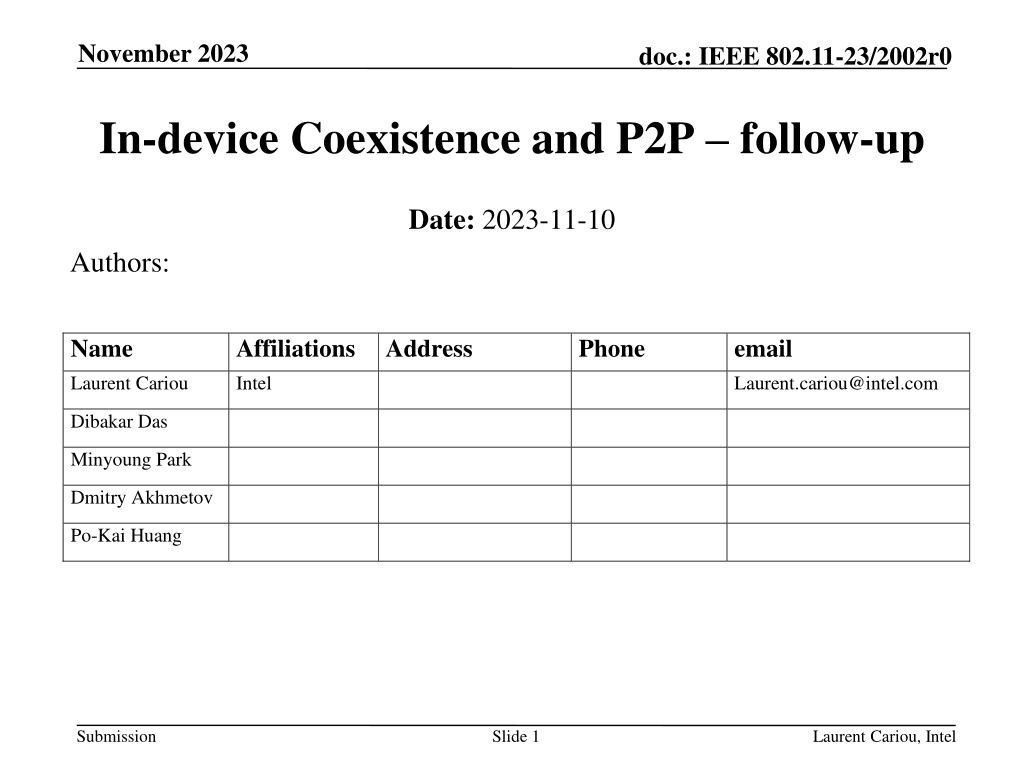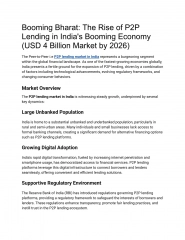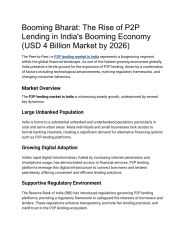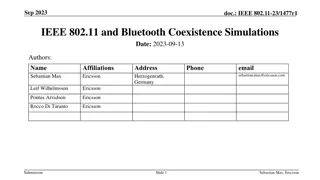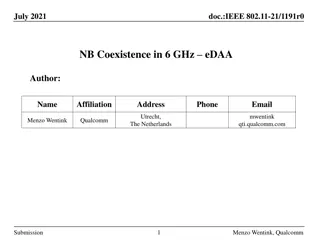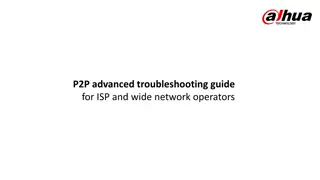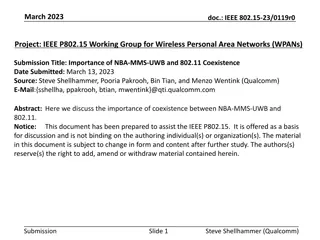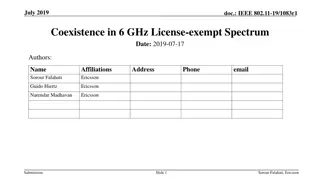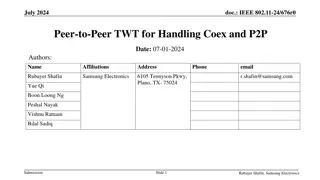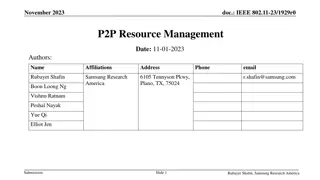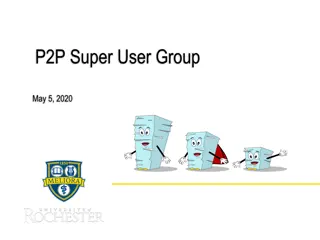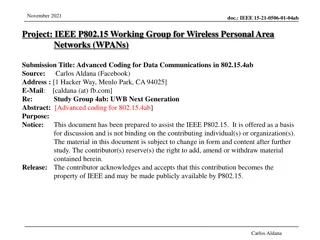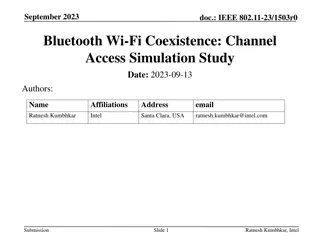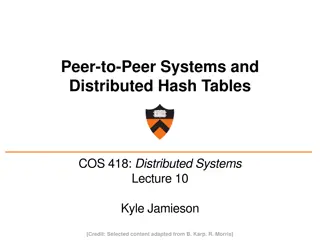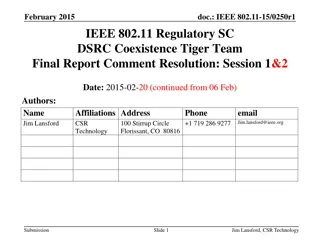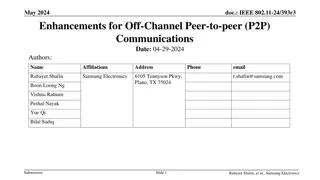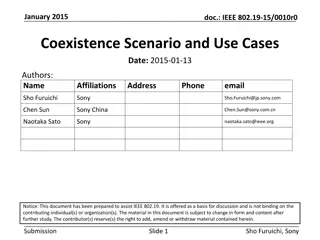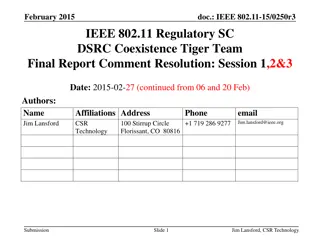Enhancing In-Device Coexistence and P2P Communication in IEEE 802.11-23/2002r0
This document discusses proposals to improve reliability in the presence of interference or other device activities within the IEEE 802.11-23/2002r0 standard. Solutions include long-term indications for periodic service periods, interference indication in the frequency domain, expected behaviors, and short-term signaling to address unexpected interferences. The classification of long-term indications for in-device coexistence is also outlined, emphasizing the identification of unavailable periods for stations and interference levels on subchannels. Suggestions for utilizing mechanisms like Broadcast TWT and AP power save schedules are provided.
Download Presentation

Please find below an Image/Link to download the presentation.
The content on the website is provided AS IS for your information and personal use only. It may not be sold, licensed, or shared on other websites without obtaining consent from the author. Download presentation by click this link. If you encounter any issues during the download, it is possible that the publisher has removed the file from their server.
E N D
Presentation Transcript
November 2023 doc.: IEEE 802.11-23/2002r0 In-device Coexistence and P2P follow-up Date: 2023-11-10 Authors: Name Laurent Cariou Affiliations Intel Address Phone email Laurent.cariou@intel.com Dibakar Das Minyoung Park Dmitry Akhmetov Po-Kai Huang Submission Slide 1 Laurent Cariou, Intel
November 2023 doc.: IEEE 802.11-23/2002r0 Summary of proposals UHR is the opportunity to improve reliability in presence of interference or other device activities We propose several solutions, for predictable or unpredictable interferences/activities Long term indication of periodic service periods during which a STA shall be considered in doze (unavailable) Long term indication of interference in frequency domain Long term expected behaviors Short term signaling in BA in case of unexpected interference to ensure no double punishment (unfavorable rate adaptation) Short term shortening/truncation of a TxOP due to upcoming interference, as a TxOP responder or TxOP holder in CTS or BA Submission Slide 2 Laurent Cariou, Intel
November 2023 doc.: IEEE 802.11-23/2002r0 Classification of long term indications for in-device coex Long term indication can be split into 3 different parts: - 1) Identification of periods of time during which the STA is completely unavailable - 2) Identification of interference levels on specific 20 MHz subchannels (all the time or possibly only during specific SPs) - 3) Description of expected behaviors in possible presence of interference (all the time or possibly only during specific SPs) Submission Slide 3 Laurent Cariou, Intel
November 2023 doc.: IEEE 802.11-23/2002r0 Classification of long term indications for in-device coex Long term indication can be split into 3 different parts: - 1) Identification of periods of time during which the STA is completely unavailable - On AP side, such information is similar to long term AP power save schedule, so we can use this mechanism - We can use Broadcast TWT with TWT ID=0 (for all STAs) and Responder PM=1 to indicate the time during which the AP is available (and therefore unavailable outside) - Unavailability field in TWT element can be set to 1 to clarify that unavailability takes precedence (even if there s an iTWT SP that happens to exist within the unavailability period) Submission Slide 4 Laurent Cariou, Intel
November 2023 doc.: IEEE 802.11-23/2002r0 Classification of long term indications for in-device coex Long term indication can be split into 3 different parts: - 1) Identification of periods of time during which the STA is completely unavailable - On STA side, there is the P2P TWT mechanism defined in 802.11 - STA informs the AP of its unavailability period(s) with a Channel Usage Request frame containing a TWT element - Following AP s successful response, P2P TWT is created during which the AP shall consider the STA as unavailable or in doze - Not a TWT agreement: TWT element just used as container to define service period, this is really an announcement - Proposal can be as simple as mandating support for P2P TWT on AP side - Alternatively: use Colocated Interference Report and add normative behaviors Submission Slide 5 Laurent Cariou, Intel
November 2023 doc.: IEEE 802.11-23/2002r0 Classification of long term indications for in-device coex Example of usage of P2P TWT notification (unavailability notification) WLAN BSS AP 1 P2P TWT Notification P2P WLAN- STA P2P AP WLAN- STA P2P Client P2P TWT Notification AP 2 WLAN BSS Submission Slide 6 Laurent Cariou, Intel
November 2023 doc.: IEEE 802.11-23/2002r0 Classification of long term indications for in-device coex Long term indication can be split into 3 different parts: - 2) Identification of interference levels on specific 20 MHz subchannels (all the time or possibly only during specific SPs) - If a 20 MHz subchannel is identified as being at a level of interference that is so high that no communication is possible, this subchannel shall not be used between the STA and the AP - This can become a sort of per-STA static puncturing negotiation for SU PPDUs between AP and STA - For MU transmissions, the STA shall not be scheduled on RUs overlapping with the interfered subchannel - Otherwise, rate selection would need to be adjusted to account for the interference - We can use Colocated interference report or define signaling Submission Slide 7 Laurent Cariou, Intel
November 2023 doc.: IEEE 802.11-23/2002r0 Classification of long term indications for in-device coex Long term indication can be split into 3 different parts: - 3) Description of expected behaviors in possible presence of interference (all the time or possibly only during specific SPs) - Sometimes difficult to react fast enough in presence of interference and long term preventive behaviors can be a good tool to have - Behaviors that can be requested: Maximum PHY rate, Max NSS, TxOP or PPDU duration limits - This is useful if applying these constraints help ensure some level of detections when the interference is present, while not harm too much performance when interference is not present - Similarly, these constraints can be applied all the time or within a specific service period and signaling has to be defined accordingly Submission Slide 8 Laurent Cariou, Intel
November 2023 doc.: IEEE 802.11-23/2002r0 Proposals for 2) unpredictable interference a) Shortening/truncation of a TxOP due to upcoming interference, as a TxOP responder or TxOP holder, and information about an upcoming unavailability period b) Add signaling in BA in case of unexpected interference to ensure no double punishment (explained before) Submission Slide 9 Laurent Cariou, Intel
November 2023 doc.: IEEE 802.11-23/2002r0 2) a) TxOP shortening/truncation and short term indication of an upcoming unavailability period Define a mechanism so that a non-AP STA recipient of a PPDU transmission can indicate, at the beginning of the TxOP that it will be available only until a specific point in time, and not after because it knows an interferer will be present at that time That would be in a CTS response or any initial control frame response Similar feedback can be provided in a BA frame during a TxOP for completeness If the STA is aware of the duration of the unavailability period, that can also be included Points to TxOP end time RTS Duration 5ms AP STA CTS Duration 1ms Points to a time after which the STA will be unavailable We also propose to allow a non-AP STA to send such information in an unsolicited manner (so as a TxOP holder possibly) Slide 10 Submission Laurent Cariou, Intel
November 2023 doc.: IEEE 802.11-23/2002r0 2) b) Rate selection in case of interference We propose to add a signaling indication in a BlockAck frame that is sent (by a responder) as immediate response to a PPDU transmission (sent by an initiator) in order to indicate to the initiator of the PPDU that the PPDU reception suffered from an unusual interference, which was the main cause of packet losses. Could be a simple 1-bit field to indicate that the PPDU reception suffered from interference or not or it could be more advanced to locate more accurately the interference impact if needed Expected behavior: Initiator will not take into account statistics of this PPDU for updating its rate selection algorithm Note that this could fit in the more general Link adaptation mechanism (rate selection based on feedbacks in the BA) if we define one in UHR Submission Slide 11 Laurent Cariou, Intel
November 2023 doc.: IEEE 802.11-23/2002r0 2) b) Rate selection in case of interference Continued.. If the transmitter already dropped the rate, it would also be good to have a way to bring the rate back up This can be a complementary signaling to specifically ask to go back to immediately preceding rate As mentioned in previous slide, this can fit in a more general link adaptation mechanism in BA, such as a simple tool to ask to go up one rate, go down one rate, or keep current rate Submission Slide 12 Laurent Cariou, Intel
November 2023 doc.: IEEE 802.11-23/2002r0 SP1 Do you agree to define a mechanism to allow a STA to optionally indicate or update a periodic unavailability in time to its peer STA? Expectation is to use existing protocols Submission Slide 13 Laurent Cariou, Intel
November 2023 doc.: IEEE 802.11-23/2002r0 SP2 Do you agree do define a mechanism so that a non AP STA that is a TXOP responder can indicate in a response frame for how long it will be available, if known and/or whether it will be unavailable after a specific point in time and, if known, for how long? Submission Slide 14 Laurent Cariou, Intel
November 2023 doc.: IEEE 802.11-23/2002r0 SP3 Do you agree do define a mechanism so that a non-AP STA as a TXOP holder can indicate in a frame for how long it will be available, if known and/or whether it will be unavailable after a specific point in time and, if known, for how long? Submission Slide 15 Laurent Cariou, Intel
November 2023 doc.: IEEE 802.11-23/2002r0 SP4 Do you agree do define a long term signaling to allow a STA to request its peer associated STA to limit the range of transmit parameters (e.g. Max MCS, Max NSS, Max PPDU size) used by the peer STA for PPDUs addressed to the STA goal is to be more resilient to possible interference on STA Rx side Submission Slide 16 Laurent Cariou, Intel
November 2023 doc.: IEEE 802.11-23/2002r0 Annex 1 Submission Slide 17 Laurent Cariou, Intel
November 2023 doc.: IEEE 802.11-23/2002r0 P2P TWT as defined in current spec STA informs the infrastructure AP of its unavailability period(s) with a Peer-to-Peer TWT agreement This is not a regular TWT agreement, TWT procedure is ignored and TWT element is just used here just to define the timing parameters of the service period Mode where the AP shall accept the Peer-to-peer TWT agreement (this is an advertisement from the STA) The only rule that applies is as follows The AP shall consider the STA in doze state during the Peer-to-peer TWT Service Period(s), and therefore not transmit to the STA during that time, unless if it receives an explicit indication that the STA is awake and available This way: The client device can easily multiplex the time used for operating with the BSS and for operating with P2P Group The infra AP is aware of the time during which the STA is unavailable and schedules it outside of these period(s) Submission Slide 18 Laurent Cariou, Intel
November 2023 doc.: IEEE 802.11-23/2002r0 P2P TWT as defined in current spec STA sends a Channel Usage Request frame to its associated infrastructure AP, which includes a TWT element describing the service period(s) during which the STA will be unavailable, and with The Usage Mode field in the Channel Usage element set to 3 for Peer-to-Peer link No Channel Entry field included in the Channel Usage element Infra AP shall respond with a Channel Usage Response frame with Accept TWT to provide a TWT Flow ID for the corresponding P2P TWT agreement Following this exchange, the Peer-to-peer TWT agreement is active and the only following rule applies: The AP shall consider the non-AP STA to be in power save mode and doze state at the start of the peer-to-peer TWT SP and back to its original power management mode at the end of the peer-to-peer TWT SP unless the AP receives a frame addressed to it from the non-AP STA within the time that overlaps with the peer-to- peer TWT SP. Submission Slide 19 Laurent Cariou, Intel
November 2023 doc.: IEEE 802.11-23/2002r0 P2P TWT as defined in current spec Timeout Interval Element (optional) Supported Operating Classes Element variable Channel Usage Elements TWT Elements (optional) Category WNM Action Dialog Token Octets: 1 1 1 variable variable 0 or 7 Figure 9-1174 Channel Usage Request frame Action field format[3155] Table 9-265 Usage Mode definitions [3145] Value 0 1 2 Usage Mode Noninfrastructure IEEE 802.11 network Off-channel TDLS direct link Noninfrastructure IEEE 802.11 network in which none of the APs belonging to the same ESS operate on the channels identified by the Channel Entry field Peer-to-peer link indication Reserved 3 4-255 Submission Slide 20 Laurent Cariou, Intel
November 2023 doc.: IEEE 802.11-23/2002r0 Annex 2 Submission Slide 21 Laurent Cariou, Intel
November 2023 doc.: IEEE 802.11-23/2002r0 In-device coexistence issue In device coexistence with Bluetooth (BT) has always been an issue. So far, this was contained in the 2.4 GHz band only. BT will now be able to operate at both 5 and 6 GHz, which makes the problem bigger than it was before. EU Regulatory is already in process of enabling Bluetooth, ZigBee and BLE operation in 5 and 6 GHz band. There are other sources of interference other wireless technologies with multi-link operation, we have other sorts of interference that can arise, and that may be sometimes difficult to predict. Multilink NSTR operation is a good example where a transmission on one link by a STA of a non-AP MLD may impact the reception of a collocated STA of the same non-AP MLD by generating some cross-link interference, In-device coexistence (spurs, modulation between components, ) Submission Slide 22 Laurent Cariou, Intel
November 2023 doc.: IEEE 802.11-23/2002r0 Other activities A STA can be associated to an infrastructure AP and have P2P or mobile AP operation at the same time, Such STA typically needs to multiplex in time its operation for infrastructure AP and for P2P A STA currently uses power mode changes with infra AP in order to signal unavailabilities (very inefficient) Negotiation of TWT SP operation could help, but difficult to describe properly the client constraints, which makes negotiation difficult or impossible Lack of a clear mechanism for a STA to inform an infrastructure AP of its constraints for P2P operation, especially a clear indication of a Service Period or Period of Time during which the STA shall be considered as in doze state and unavailable Submission Slide 23 Laurent Cariou, Intel
November 2023 doc.: IEEE 802.11-23/2002r0 Predictable/unpredictable interference 1 Some interference may be predictable For such interference, tools are needed in order to define properly the period during which the interference occurs, and possibly characterize the interference Some BT can be scheduled in some cases 2 Other interference are difficult to predict long in advance This is often the case for BT interference We therefore need solutions in order to react properly when interference occurs, and not have reactions that impact even more a Wi-Fi connection. 3 Other possible interference situation Some interference are in the middle For instance, periodicity for interference period is known, but interference may not always occur during such period Submission Slide 24 Laurent Cariou, Intel
November 2023 doc.: IEEE 802.11-23/2002r0 Interference impact Obviously, when interference occurs, it impacts ongoing transmissions/receptions Reducing SINR if interference occurs during reception, often leading to packet losses Or forcing unavailability of the STA with very short notice Stopping ongoing transmission if priority is given within the device for another wireless technology, Double punishment: When interference occurs to a received PPDU and causes packet losses, not only can some packets be lost, but the rate selection mechanisms on the transmitter side may get adjusted to lower the rate of subsequent transmissions, as the transmitter does not know that the packet losses was not due to the channel conditions but was due to unexpected and infrequent interference. Submission Slide 25 Laurent Cariou, Intel
